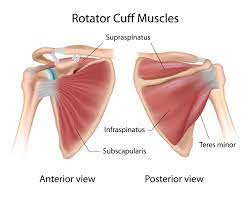So you think that nagging pain in your shoulder is due to a shoulder impingement? This is not an uncommon problem! Impingement of the shoulder is commonly seen a lot at clinics. One of our patients, John, had been experiencing shoulder pain for months and was diagnosed with shoulder impingement. He followed a customized plan for a few weeks, and his pain decreased significantly.
The shoulder is made up of 3 bones: the Humerus(arm bone), the Scapula(shoulder blade), and the Clavicle(collar bone). The rotator cuff is a term you may have heard mentioned many times when talking about the shoulders and shoulder injury. They often play a part in shoulder impingement cases. The rotator cuff muscles are a group of muscles that attach the arm bone to the shoulder blade.
Shoulder diagram courtesy of OrthoInfo

The rotator cuff is made of the following muscles:
- Supraspinaturs
- Infraspinatus
- Subscapularis
- Teres Minor
These muscles help to raise and rotate your arm and hold the arm bone in the socket of the shoulder blade throughout movement. There is also a bursa that sits underneath the acromion of the shoulder blade – that pointy, bony part at the top of your shoulder. The bursa helps reduce friction between the acromion and the rotator cuff tendons.
Rotator cuff diagram courtesy of Jeffrey Berg

Bad posture can lead to dysfunctional biomechanics and an impinged shoulder by causing the muscles of the socket girdle to become tight, resulting in limited arm bone movement in the socket. Common symptoms of shoulder impingement include pain when reaching up, pain when lying on the affected shoulder, and pain when reaching behind your back. Talking to a therapist about your painful shoulder will help you confirm whether or not you have shoulder impingement. They will also do specific tests to determine the cause of your painful shoulder.
There are 7 steps to fixing your shoulder impingement and decreasing your pain:
While shoulder impingement can be painful and affect daily activity. There are steps you can take to reduce the effects of shoulder impingement and get back to proper shoulder health!
Here are 7 steps you can start with:
Step 1: Pause and explore ALL activities that cause or increase your pain! This gives your shoulder time to rest and recover.
Step 2: Reduce inflammation by using ice, anti-inflammatory medication, or ultrasound therapy.
Step 3: Perform targeted stretches and exercises to improve flexibility and strength in the shoulder and surrounding muscles.
Step 4: Correct your posture and improve your body mechanics to reduce the strain on your shoulder.
Step 5: Strengthen your core muscles to improve your overall body stability and reduce shoulder strain.
Step 6: Consider using modalities like acupuncture or massage therapy to help reduce pain and improve function.
Step 7: Gradually return to your regular activities and sports, but make sure to use proper form and technique to avoid re-injury.
Shoulder impingement is a common problem that can be effectively treated with therapy. By following a customized plan of care that includes targeted stretches, exercises, and modalities, you can decrease your pain and improve your shoulder function. If you are experiencing shoulder pain, don’t hesitate to contact us for a 15 minute consultation with one of our shoulder impingement specialists. We can help you get back to doing the activities you love pain-free.
Don’t let your shoulder impingement stop you from living your life. Keep moving and doing the things you love; the best is yet to come!
FAQ
Does shoulder impingement require surgery?
Surgery is not the first line of action to treat impingement of the shoulder. There is much more evidence supporting therapy of the shoulder which will include appropriate exercises for the problem. Ask your therapist for more information.
Can I continue to exercise with shoulder impingement?
You should stop any activities that cause or increase your pain until your shoulder recovers. Your therapist can help you develop a modified exercise plan that won’t exacerbate your impingement and will help you maintain your fitness level.
